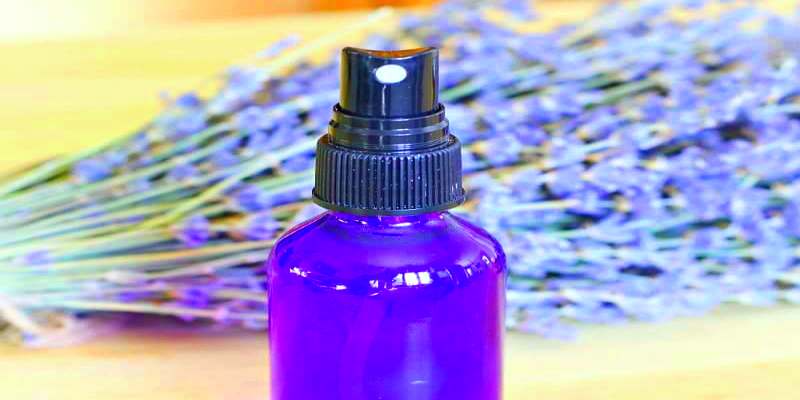How do you make air freshener spray? Our guide outlines how to do this easily with natural ingredients that are much healthier than commercial chemicals.
Find more home guides, tips and advice
The trash can, the litter box, food on the stove, cold smoke … Before a bad smell spoils your mood, quick help comes with a room spray. This is particularly the case where the air cannot circulate because there is no window. If visitors have announced themselves, room sprays are a quick and effective rescue to be able to smell the apartment again. Room spray does not have to be expensive and does not contain any harmful substances. Find out now how you can easily make air freshener spray yourself.
Why make air freshener spray yourself?
After the room spray is distributed in the room, we breathe it in. The particles enter the lungs and blood via the air we breathe. Commercially available room fragrances contain artificially produced fragrances, which accumulate in our body and, last but not least, can be responsible for the development of cancer and other diseases.
So far, relatively little research has been done into how fragrances affect our health. However, it has been found that artificial fragrances can trigger allergies. Fragrances are not only distributed in the body, they are also absorbed through the skin and can cause inflammatory reactions as contact allergens. In addition, various fragrances are difficult to degrade and thus pose a direct threat to the environment.
If the indoor climate is to be sustainably improved, industrial products are therefore less suitable. To make air freshener spray yourself offers a welcome alternative here. With little effort, natural fragrance mixtures can be created according to your own taste. This not only saves money, but is also beneficial to health and the environment.
The advantages of a natural room fragrance
- natural ingredients
- individual fragrance notes
- inexpensive to buy
- sustainable
- quickly manufactured
- many variations
Natural room fragrance throughout the house
| Living room | recommended fragrance |
|---|---|
| living room | Orange lemongrass bergamot rosemary |
| bathroom | Orange peppermint tangerine grapefruit |
| kitchen | Lemon Rosemary Lavender Cinnamon |
| bedroom | Lavender Melissa Zirbe Orange |
Make air freshener spray
Some basic substances are needed to produce a natural room spray:
- water
- alcohol
- Baking soda
- volatile oil
Why alcohol?
The addition of alcohol (at least 40 percent) fulfills some functions. The spray then lasts for a longer period of time, the added fragrances are optimally dissolved and alcohol has a disinfecting effect.
»Tip: Since the alcohol evaporates when atomized, it has no effect on the smell of the room spray.
And without alcohol?
The room spray can also be made without alcohol. Boiled or distilled water should always be used for a longer shelf life. The durability of the spray is limited to a few weeks without alcohol. Therefore, smaller quantities should be produced, which can be consumed more quickly.
Why baking soda?
Soda can neutralize bad smells and is therefore particularly advantageous as an addition to the room spray.
Why essential oil?
The essential oils provide the fragrance of the room spray. In addition, the natural fragrances also have different effects on the body and the psyche. Essential oils can have an invigorating, calming or disinfecting effect. You can choose from a wide range and the composition can be adjusted both according to your favorite fragrance and taking into account the respective effect.
Make air freshener spray: step by step
Ingredients:
- 300 milliliters of water (preferably boiled or distilled)
- 100 milliliters of alcohol (alcohol content not less than 40 percent vol.)
- 20 grams of baking soda
- five to ten drops of essential oil of your choice
Method:
- Dissolve the baking soda in water
- Mix water and alcohol
- Put essential oil in the atomizer
- Pour liquid into the atomizer
- Shake the liquid well
First, the baking soda is dissolved in the water. This is quicker and easier if the liquid is at room temperature. Then water and alcohol are poured into a measuring cup. When choosing alcohol, vodka or the cosmetic base water consisting of 95 percent ethanol have proven their worth. The liquid is filled into the atomizer with the help of a funnel. To ensure that all components connect well, the room spray should be shaken well before use.
Make natural fragrances yourself
If you don’t want to use essential oil, you can also create the fragrance yourself. So-called hydrolates can be produced from fresh parts of plants. Hydrolates consist of the condensate obtained as a by-product in the extraction of essential oils.
»Tip: Hydrolates should be dosed higher than essential oils and are also less durable.
The production of these natural fragrances is quite complex. If you only want to produce small quantities, you can use an espresso pot. However, this should be cleaned well before use. The result of this method is not a hydrolate in the actual sense, but a highly concentrated liquid that can be used in a similar way. The lower tank of the machine is filled with water as usual. The plant parts are placed in the sieve. Now the jug is screwed on and heated on the stove. The condensed water is then filled germ-free and, in addition to room fragrances, creams, perfumes or hair care products can also be added.
Application:
The atomizer should always be shaken well before each use. The essential oils do not completely dissolve in the alcohol and should therefore always be well distributed in the liquid.
»Tip: The use of a room spray does not replace regular ventilation of the premises.
The room spray can, depending on your preference, be spread several times a day in the room. The fragrance mixtures can be individually selected and matched to the room, so that the use of several atomizers is also worthwhile.
Some popular fragrance blends:
- Lavender and lemongrass
- Peppermint and lemon
- Grapefruit and eucalyptus
- Lemon and thyme
Fresh fragrance with peppermint
A room spray with a fresh peppermint scent is particularly recommended for the bathroom and toilet. For this purpose, the peppermint oil is mixed with the other ingredients as described.
»Tip: With the addition of orange or grapefruit oil, the room spray can also be used in the living room.
Flowery scents from your own garden
A little patience is required to make this room fragrance. Rose petals are collected in the garden. About three hands of the fresh flowers are now mixed with 100 milliliters of high-proof alcohol in a closable container. Place the glass in a sunny place for about 14 days so that the fragrances of the rose petals can combine well with the alcohol. The broth is then filtered, filled into an atomizer and mixed with distilled water.
Citrus fragrance as an all-rounder
The freshness of citrus scents simply puts you in a good mood. In addition, a natural room spray can be produced easily and quickly. The zest of a lemon is mixed with 100 milliliters of alcohol. Stored in a closed glass, the mixture is ready for use after only two to three days. Before use, the liquid is poured through a coffee or tea filter and then filled into the spray bottle and mixed with water.
Individual fragrance mixtures for all needs
Very different room scents can be created. Here are some suggestions:
| Desired effect | Recommended fragrances |
|---|---|
| Freshness | Peppermint citrus rosemary |
| Relaxation | Melissa lavender spruce needles |
| Energy boost | Mint lemon eucalyptus |
| Repelling insects | Basil cloves laurel |
| Sleep aid | Lavender cinnamon chamomile |
| Positive energy | Mint eucalyptus citrus |
| romance | Rose vanilla orange |
| Advent mood | Orange cinnamon cloves |
Natural room fragrance with the help of a fragrance glass
You can also create a natural and subtle room fragrance by setting up a fragrance glass.
Ingredients:
- Jar with lid
- Baking soda
- dried parts of plants
- volatile oil
Method:
- Fill the glass with baking soda
- Pour in dried plants
- Mix the contents well
- Close the jar
- Drill holes through the lid
Half of the glass is filled with baking soda. Then the dried plants, herbs or flowers are added. Now the whole thing is mixed well. In order for the scent to escape into the room, the lid must be provided with small holes.
»Tip: Alternatively, an air-permeable fabric can be stretched over the lid.
If you don’t have any dried plant parts in stock, you can simply add a few drops of essential oil to the baking soda.
Make a room fragrance diffuser
A diffuser does not need to be atomized like a room spray to release the fragrance into the room, but instead constantly supplies the room with fresh fragrance. Diffusers can also be easily manufactured by yourself.
Ingredients:
- Bottle or bottle
- some bamboo sticks
- Vegetable oil
- volatile oil
Method:
- Pour vegetable oil into the jar
- add essential oil
- Dip the sticks into the mixture
- Turn the sticks over
Suitable glasses are all flacons or bottles that have a longer, narrow bottle neck. First, 200 milliliters of vegetable oil are poured into the jar.
»Tip: Preferably use sunflower oil. In any case, it should be an odorless vegetable oil.
Now the essential oil is added as desired. About ten drops should be enough to give the room a subtle scent. If necessary, the dose can be doubled at any time. Depending on the size of the vessel and the circumference of the bottle neck, four to ten sticks are needed. In addition to bamboo sticks, commercially available kebab skewers are also suitable. These are first immersed in the liquid and then turned over. The upper end of the stick is already wetted with the fragrance oil and the fragrance can spread faster in the room.
Don’t forget to ventilate!
Even if the most diverse ideas for a natural room fragrance have now been found, regular ventilation is still part of the program. Even the best room spray cannot do much against stale and stale air and the atmosphere of wellbeing in the room does not want to develop if there is a lack of oxygen in the room.
Regular ventilation has proven its worth. Opening the windows several times a day for five to ten minutes is more effective than leaving them slightly tilted over a longer period of time. No air exchange can take place through the small gap. This is required to make the room air appear fresh again.
»Tip: Even in winter, ventilation should not be neglected. The heating should be turned off.




